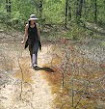And he is worth mentioning again.
Yesterday, a landscaper / urban ecology student friend-of-mine told me "I give this to book clients, and they tell me this book changed my life."
...and their plant selections.
I can get behind any book that can achieve that kind of ecological literacy. As Garden Rant's Susan's Harris said and Wild Flora neatly summarized: "Tallamy makes the case for native-plant and wildlife-friendly gardening in a way that many conventional gardeners have been able to accept and understand."
Also, since the hard cover book came out in 2007, Tallamy's given us some updates that I've been meaning to share.
While I initially appreciated the book's message...
[if you missed it, here it is in a nutshell: Tallamy's an entomologist and a former long time "conventional" gardener. He observed his garden, did the research and noticed that -- in some really fascinating and informative proportions -- it's the native plants which feed the native insects -> both of which feed and support native birds, whereas non-native species are less frequented, and often detrimental to the same cycles = the plants you choose to garden with in your yard matter to the conservation, or extinction, of biodiversity.]
...what I really wanted was a paperback edition (more affordable to give to folks) and access to the raw data (those spreadsheets rocked, and even helped validate, my little world) and a journal article (very cool analysis + succinct read + something you can credibly cite).
As you can see, Tallamy has since delivered all that.
BTW: It wasn't until that Conservation Biology journal article came out that I started to see Tallamy's book crack into ecological restoration and conservation discussions / emails. Until then, I mostly saw the book mentioned in popular gardening magazines, public workshops, and gardening blogs south of the border (like folks were starved for it too. I started to feel spoiled guilty about how well Lorraine Johnson had already nourished me and the rest of southern Ontario about native plant gardening ecology. Also, at first it was hard for me to "get" how new (and thus, how that much more profound) Tallamy's message was for a lot of folks, because our endangered->extirpated Karner Blue butterfly's dependence on our at-risk Wild Blue Lupine Lupinus perennis had already taught us a hard lesson about why we need to conserve and restore our native obligate larval host plants too).
I appreciate the effort to appeal to folks who want to cut-to-the-chase like that, but... here's my advice and my caveats about these and other general native plant recommendation lists / short cuts.
As insightful as the book site's plant recommendations are, those rankings are restricted to butterfly and moth visits. In the mid-Atlantic states.
That's no substitute for knowing your yard, local native plant communities (and all sorts of insects, pollinators and wildlife).
Besides, discovering those fine details is half the fun.
In case 'high wildlife value' or 'obligate plant host' (aka native plant) gardening is new to you, you'll still want to choose:
-plants that are native to your unique neck-of-the-woods (eco-region, eco-district, seed zone, or even indigenous to your watershed)
-appropriate to your yard's conditions
-from what you can ethically source (by seed or through nurseries)
My advice? When the weather starts to warm, bring this book, and any species short-lists it inspires, to your local native plant nurseries and ask them which native plant species they would recommend for your very unique patch of the planet.
And ask them for some related gardening -> naturalization -> restoration & conservation advice. (BTW: I do think that, as soon as you start gardening with native plants, these successive gradations are an inevitable path).
I've had nursery owners take-me-to-school for an hour. It helped to go back, when it wasn't a spring weekend frenzy. And it helped when I attended their public education lectures and workshops too.
Or, if you're not the DIY type, ask the native plant nursery owners for referrals to land care professionals they personally recommend. Lately, I've been searching for easy-to-hand-out standards about how to choose land care professionals, and honestly, this is what experience has taught me so far: The good native plant nursery folks know the good native plant consultants and landscape contractors. I can't say that any plainer. And no, it's not an insiders club, a membership they buy, an association they join or an accreditation. It's the fact that seed source and ethical informed seed collection and propagation standards are sound measurements of what you're getting, and ultimately it's the seed collectors/growers/nurseries who can tell you what standards they follow and which local landscapers, consultants and contractors are demanding and applying those standards in their plant selections too. Also, by their nature, native (and especially indigenous) plants are products of truly localized networks (often you can still expect to know where your garden's native plants come from, in a way a lot of still wish we knew where our food comes from: there are no "5000 mile" native plants) where folks know each other over time: bet-their-reputations-on-it referrals still mean something.


2 comments:
Thanks for the shout-out. Doug Tallamy is definitely at the top of my list of Ecosystem Gardening Heroes.
He has made the best argument I have ever seen for the use of native plants in our landscapes and their importance for wildlife survival.
This book shoud be read by every homeowner, land manager, business owner, etc to make the best choices for being stewards of their land.
Great book! I mentioned this book in a comment on the Garden Professors blog that was complaining about native plant enthusiasts. Someone accused people of misusing the book to inappropriately promoting natives plants, but did so by misstating the thesis of the book.
Post a Comment